
eBook - ePub
Old New York in Early Photographs
Mary Black
This is a test
- 228 pages
- English
- ePUB (adapté aux mobiles)
- Disponible sur iOS et Android
eBook - ePub
Old New York in Early Photographs
Mary Black
Détails du livre
Aperçu du livre
Table des matières
Citations
À propos de ce livre
New York City as it was 1853-1901, through 196 wonderful photographs: great blizzard, Lincoln's funeral procession, great buildings, much more.
Foire aux questions
Comment puis-je résilier mon abonnement ?
Il vous suffit de vous rendre dans la section compte dans paramètres et de cliquer sur « Résilier l’abonnement ». C’est aussi simple que cela ! Une fois que vous aurez résilié votre abonnement, il restera actif pour le reste de la période pour laquelle vous avez payé. Découvrez-en plus ici.
Puis-je / comment puis-je télécharger des livres ?
Pour le moment, tous nos livres en format ePub adaptés aux mobiles peuvent être téléchargés via l’application. La plupart de nos PDF sont également disponibles en téléchargement et les autres seront téléchargeables très prochainement. Découvrez-en plus ici.
Quelle est la différence entre les formules tarifaires ?
Les deux abonnements vous donnent un accès complet à la bibliothèque et à toutes les fonctionnalités de Perlego. Les seules différences sont les tarifs ainsi que la période d’abonnement : avec l’abonnement annuel, vous économiserez environ 30 % par rapport à 12 mois d’abonnement mensuel.
Qu’est-ce que Perlego ?
Nous sommes un service d’abonnement à des ouvrages universitaires en ligne, où vous pouvez accéder à toute une bibliothèque pour un prix inférieur à celui d’un seul livre par mois. Avec plus d’un million de livres sur plus de 1 000 sujets, nous avons ce qu’il vous faut ! Découvrez-en plus ici.
Prenez-vous en charge la synthèse vocale ?
Recherchez le symbole Écouter sur votre prochain livre pour voir si vous pouvez l’écouter. L’outil Écouter lit le texte à haute voix pour vous, en surlignant le passage qui est en cours de lecture. Vous pouvez le mettre sur pause, l’accélérer ou le ralentir. Découvrez-en plus ici.
Est-ce que Old New York in Early Photographs est un PDF/ePUB en ligne ?
Oui, vous pouvez accéder à Old New York in Early Photographs par Mary Black en format PDF et/ou ePUB ainsi qu’à d’autres livres populaires dans Kunst et Geschichte der Fotografie. Nous disposons de plus d’un million d’ouvrages à découvrir dans notre catalogue.
Informations
Sujet
KunstSous-sujet
Geschichte der FotografieI
THE BATTERY AND THE EAST RIVER WATERFRONT
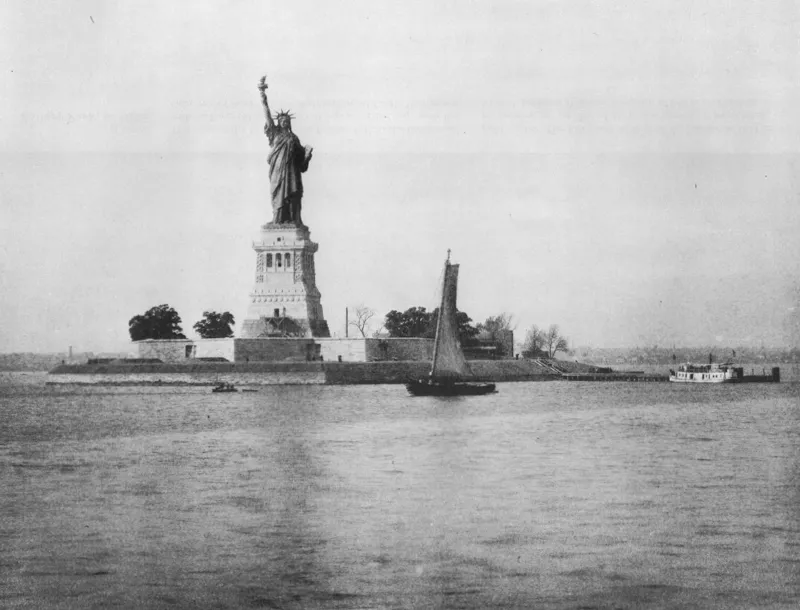
Photo, Edward Bierstadt
[PLATE 1]
Liberty Enlightening the World,
c. 1886
Liberty Enlightening the World,
c. 1886
This shimmering view of the lady in the harbor was issued inquantity by Artotype, Bierstadt’s name for the multiple-printphotoprocess he used. Edward Bierstadt, who was a printer aswell as a photographer, was the brother of the celebrated landscape artist Albert Bierstadt. This print, presented to the Society in 1890, probably records the appearance of the figure shortly after it was dedicated in 1886.
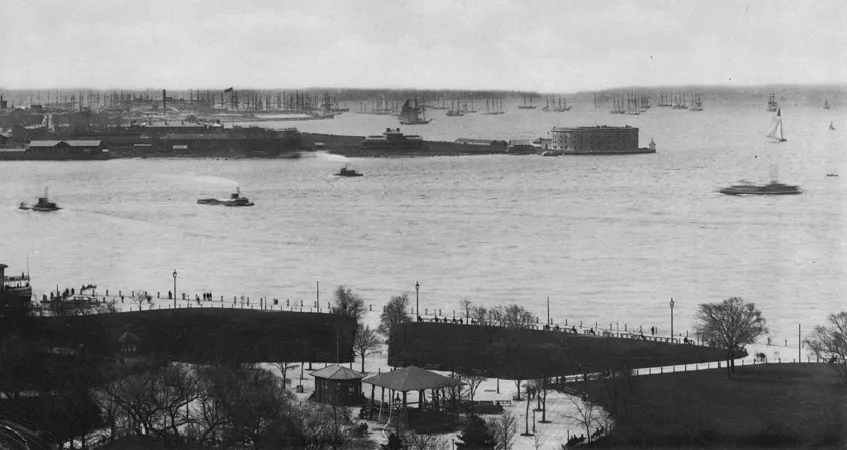
[PLATE 2]
Battery Park, c-1885
Battery Park, c-1885
This view of the harbor shows Battery Park in the foreground with the Barge Office at the left. Before a forest of ship masts lies Governor’s Island with the fortifications of Castle Williams at right center. The fort, built to defend the harbor in 1811 in preparation for the War of 1812, was named for its architect, Lt. Col. Jonathan Williams, a nephew of Benjamin Franklin.
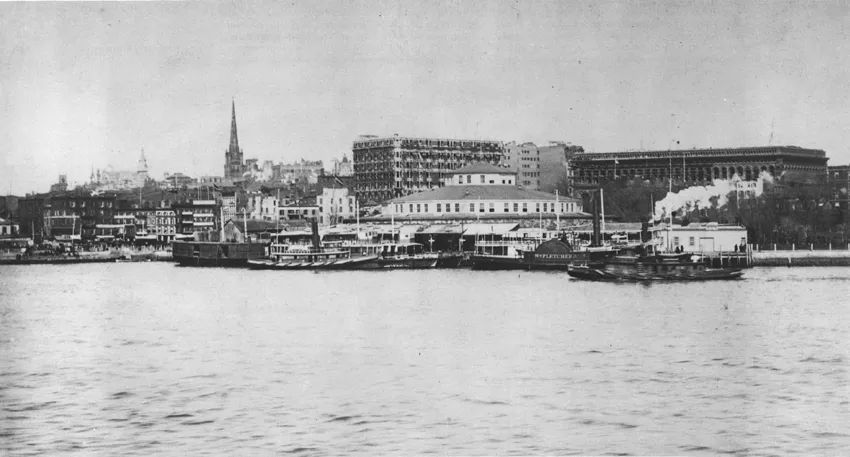
[PLATE 3]
Skyline at the Battery, 1883
Skyline at the Battery, 1883
Visible in this late nineteenth-century photograph of the Manhattan skyline are (from left to right) the Western Union Telegraph Building, Trinity’s steeple, the Washington Building, Castle Garden, and the Produce Exchange. Castle Garden, earlier called Castle Clinton, was built c. 1807; from the 1820s to the 1850s it was an important theater and assembly hall; from 1855 to 1890 it was New York’s immigrant station; from 1896 to 1942 it housed the New York Aquarium. Today it resembles the fort as it was originally built. (The side-wheeler William Fletcher was out of Boston.)

[PLATE 4]
Bowling Green, 1898
Bowling Green, 1898
This view, taken from a high window on the east side of lower Broadway, shows Bowling Green, New York City’s first park, as it appeared about 100 years after it was enclosed by the fence seen here. The buildings at the left are part of Steamship Row, and Battery Park appears in the distance. Broadway begins at the right, the second building, 7-11 Broadway, having been completed the year this picture was taken. Designed by W. G. Audsley, its impressive Egyptian Revival facade incorporates ancient pillars into the design of the entrances. The recruiting tent in the foreground and the bare branches on the trees set the photograph date to the start of the Spanish-American War (declared April 25th). Dimly seen at the end of the park is the seated figure of Abraham de Peyster by George Edwin Bissell, installed just two years before near the spot where the equestrian statue of George III was torn down by an irate populace on July 9, 1776.
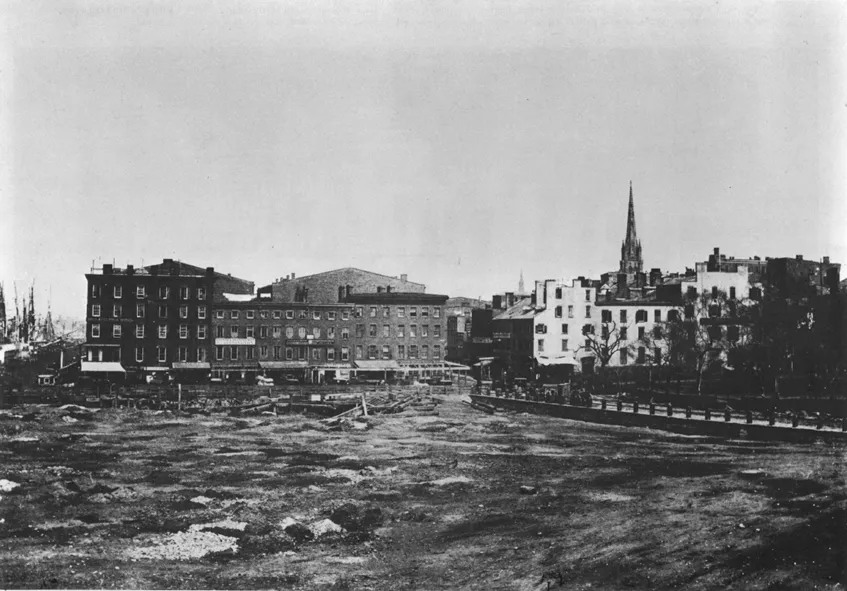
Photo Victor Prevost
[PLATE 5]
Battery Place, 1853
Battery Place, 1853
This early view looking north from Battery Place was taken by the French photographer Victor Prevost, who came to New York in 1848. Soon after his arrival he began work on one of the earliest existing photographic records of the city. The present picture is one of the 'earliest outdoor photographs of New York known today. Taken while the Battery was being enlarged, it shows the steeples of nearby Trinity Church and, in the distance, St. Paul’s Chapel.

[PLATE 6]
State Street, c. 1864
State Street, c. 1864
A row of fine Federal houses facing Battery Park—on the west side of State Street just south of Bowling Green—is captured in this photograph of the Civil War period. A recruiting office is set up on the ground floor at No. 16, where a poster at the door offers a bounty of $800 to each enlistee. The other buildings are also in use as military offices.

[PLATE 7]
No. 7 State Street, c. 1888
No. 7 State Street, c. 1888
Facing Battery Park and planned to fit the curve of State Street is the Federal house built for James Watson in the early nineteenth century, supposedly from designs by John McComb, Jr. At the time of this view, the facade had been painted and the windows and doors highlighted in imitation of bold Georgian architectural detail, less in keeping with the elegance of the original house than its later restoration as part of the Shrine of Blessed Mother Seton. The horse-drawn street sprinkler is an independently important detail in this late nineteenth-century photograph of an early New York mansion that is still standing.
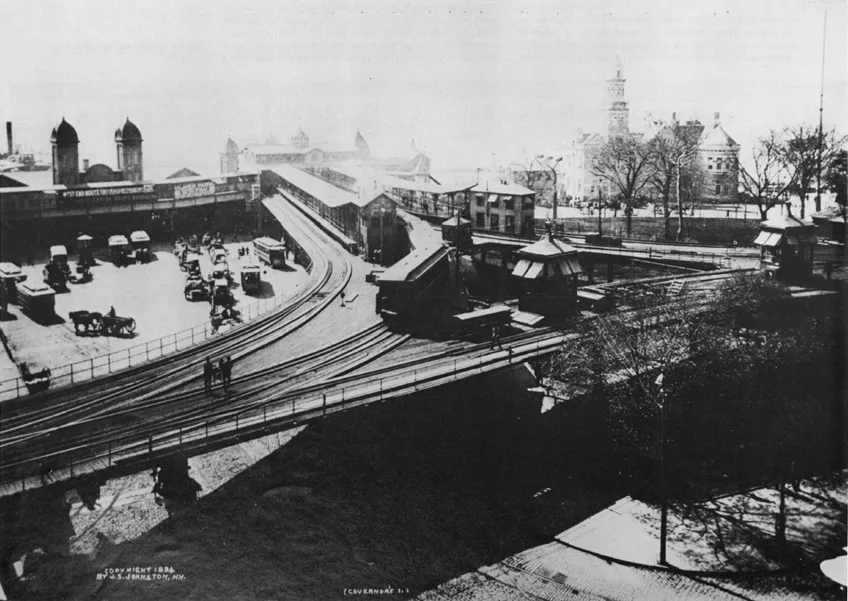
Photo, John S. Johnston
[PLATE 8]
South Ferry Y, 1894
South Ferry Y, 1894
The dramatic sweep of the South Ferry Y, which was the southern terminal of the el, is seen from Whitehall Street in this copyrighted print dated 1894. The Coney Island Ferry (in the slip at far left) took passengers direct to Buffalo Bill’s Wild West Show. At the far right is the turreted splendor of the Barge Office.

Stereograph, American Illustrated Company
[PLATE 9]
Brooklyn Ferry Stop, c. 1870
Brooklyn Ferry Stop, c. 1870
This ebullient Victor...